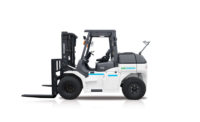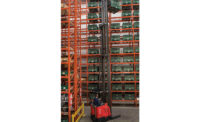The impact of e-commerce, increased SKUs and just-in-time demands place an extra complexity to how manufacturing facilities and distribution centers operate. How does one incorporate Internet of Things (IoT), advanced robotics, wireless technologies and/or other cutting-edge solutions?
In this special report, lift truck providers reveal trends, challenges, solutions and what cold food and beverage processors need to know in order to keep the cold food industry moving forward.
Turning data into intelligence
Data is key to understanding how a business operates. Data provides intel on customer’s habits, costs and movements. It shines the light on efficiencies and wastes, and brings customers closer to manufacturers and distributors, says Darren Stratton, product manager, PressOn material handling for Camso, Canada.
“What we see with larger fleets is that managers are becoming more and more conscious of how much it’s costing to maintain an entire fleet of forklift trucks,” he says.
That’s why Camso developed a Usage Intensity Calculator, which analyzes the level of forklift application intensity and recommends the appropriate tire to provide maximum tire life.
Furthermore, implementing wireless fleet management and requiring data liberation from advanced robotics and automation systems to aggregate data with existing warehouse management systems will provide a more granular view of warehouse operations, says John Rosenberger, manager of iWAREHOUSE Gateway and global telematics for The Raymond Corp., Greene, N.Y.
“The use of virtual reality and augmented reality are additional trends impacting the future of cold food processing and warehouse distribution,” he says. “Progressive companies are combining the human aspects of their operations with these technologies to address labor shortage and training needs.”
An increase in products will necessitate new slotting and order picking methods, says Sue Rice, product manager of pallet trucks and stackers for Raymond. Companies will also look for ways to increase employee comfort and drive productivity with the use of heated seats, floorboards and drive handles, cameras, ergonomically designed features and LED lighting, Rice adds.
For instance, Raymond’s Pick2Pallet LED light system integrates put-to-light LED lights within the pallet truck’s forks and the customer’s warehouse management system and voice-pick system to drive increased productivity and minimize pick errors.
“Limited space is challenging warehouses to reconsider slotting strategies,” says Rice. “Because food and grocery is one of the harshest warehouse environments, Raymond redesigned its center rider, modifying it from a 3-wheel to 4-wheel design. Another challenge is pick accuracy. Pick error reduction is especially critical, as warehouses move into omnichannel distribution and the delivery of product directly to the consumer.”
Meanwhile, lift truck telemetry systems, such as Yale Vision, can uncover myriad insights about fleet utilization, operator performance and facility layout, says Shelley Bell, industry manager, warehouse solutions for Yale Materials Handling Corp., Greenville, N.C.
“For example, even after gathering only a month’s worth of data, facility staff can identify areas with idle trucks, find opportunities to reduce fleet size through process improvements and identify specific order selector models well-suited for picking processes,” she adds. “It’s not a one-size-fits-all approach. For an example of this customized, application-based approach, consider direct-store-delivery.”
Another instance is meal prep kit services, which require expansive warehouse space and the location required for delivery of perishable items.
“The use of multi-level lift trucks with a slotting strategy optimized for their picking range can reduce pick time, rack requirements, operators and overall cost per case in and out the door,” says Bell.
Another trend is the data convergence enabled by big data, adds Jim Gaskell, director of global technology business development for Crown Equipment Corp., New Bremen, Ohio.
“The warehouse is more connected today than yesterday, and will be more tomorrow than today. Businesses that aggregate the data into a central intelligence center for analysis and action stand to gain competitive advantage,” says Gaskell.
On the other hand, consumer buying behaviors are causing changes in how goods are picked and handled, he adds. That’s why Crown developed QuickPick Remote technology, which automates picking tasks to simplify workflow, save time, reduce risk and increase productivity.
Automation adds more solutions
There is also a movement toward more automation, especially automated storage retrieval systems, says Perry Ardito, general manager, Jungheinrich warehouse products group for Mitsubishi Caterpillar Forklift America, Inc. (MCFA), Houston, Texas.
“Automation allows facilities to operate 24/7 while maximizing storage density and productivity,” adds Ardito. “Warehouse structures are sometimes difficult to modify due to the building structure supporting the automated system. We offer turret trucks and high-level order pickers that feature our semi-automated technology known as Warehouse Navigation, which uses RFID technology to help increase productivity by up to 25%. Transponders embedded in the floor precisely identify aisle locations and distances.”
Regulation adds increased worker safety
Worker safety is also one of the most important aspects of business operations, adds Gaskell.
“Forklifts equipped with fleet and operator management systems such as Crown’s InfoLink system provide information for warehouse managers to review activity by operator, analyze productivity across all facilities, departments and shifts and make sure the right equipment is being used for the task. The presence of technology on the forklift supports a safety culture,” he says.
Regulation also entails basic cleanliness, hygiene and housekeeping, says Bob Hasenstab, general product manager, KION North America, Summerville, S.C.
“This leads to no glass, specialized batteries, dedicated materials, etc. There will be more workplace regulations considering the harsh environment, leading to worker fatigue due to heavy protective gear to combat the cold,” he adds. “Use dedicated ‘stay in’ equipment with freezer cabs that allow operators to work a full shift without more stoppage time. These heated cabs have features like dual-pane, shatterproof windows, heating strips with block-outs for scanners, heated seats, insulation and energy saving systems.”
How batteries charge the industry forward
Lithium-ion batteries are making waves in the cold food industry, as they provide a number of benefits such as additional energy storage in a smaller footprint, low internal resistance, more opportunity-charged and more applicable in cold and freezer applications.
“Lithium ion will continue making its way into the market for forklift applications, and NexSys Thin Plate Pure Lead technology may be close behind,” says Erica Moyer, product manager of energy storage solutions for The Raymond Corp. “Traditional lead-acid batteries are prone to heat loss in cold or refrigerated areas. [We] have developed an 8250 walkie pallet truck with integrated heaters in the pack that will turn on in cold storage environments for optimal lithium-ion battery performance.”
Current challenges with lead acid batteries entail low energy availability in cold environments, spillage, gassing during charging, freezing of acid, maintenance of acid levels and more, says Hasenstab.
“With lithium-ion technology, all of these worries are gone,” he adds. “This technology is not sensitive to cold, does not require constant acid level maintenance, delivers stabilized energy and can be charged anywhere.”
Meanwhile, faster refueling/charging and greater uptime are important goals for lift truck fleets, adds Bell.
“Hydrogen fuel cells offer a solution to achieve higher operational productivity, eliminate cumbersome battery charging infrastructure and deliver consistently high performance,” she adds. “They also occupy a smaller footprint, using only a compact hydrogen generator and auxiliary equipment located outside, rather than battery charging and storage rooms taking up valuable warehouse space.”
When it comes to forklift batteries, it’s all about performance—the longer they can perform, the better they are for business, says Gaskell. Crown offers a Battery Health Monitoring System, which looks beyond the limited data checkpoints of the battery room and instead collects real-time information about the battery as it’s used.
“A battery health monitor can more accurately identify neglected batteries, as well as determine which charging method works best for each battery and which batteries work better in certain trucks and applications,” he says.
Delta Products Co. sees wireless charging as a game-changer in the industry, as there is no need for human intervention and no connectors or cables required.
“Combined with lithium-ion batteries, both manned and unmanned vehicles can take frequent, short opportunity or fast charges and go about their work at maximum performance, 24 hours a day, seven days a week,” says Don Nasca, senior account manager for the Fremont, Calif., company. “Wireless charging systems can be designed to handle different vehicles with different batteries, so they can share common charging locations throughout a facility or multiple facilities. These systems employ both wireless and CANBus communications. Complete information about the status and health of every vehicle and battery can be known, so the entire fleet can be managed from one or multiple locations.”
Regardless of the challenges ahead— e-commerce, increased SKUs and just-in-time demands, among others—today’s lift trucks and batteries are in position to keep cold food and beverage processors moving forward.















